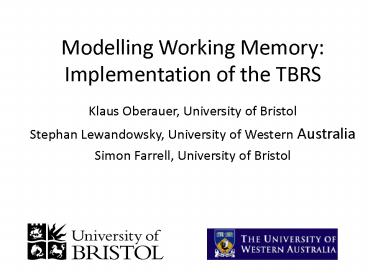Modelling Working Memory: Implementation of the TBRS PowerPoint PPT Presentation
1 / 29
Title: Modelling Working Memory: Implementation of the TBRS
1
Modelling Working Memory Implementation of the
TBRS
- Klaus Oberauer, University of Bristol
- Stephan Lewandowsky, University of Western
Australia - Simon Farrell, University of Bristol
2
The Time-Based Resource-Sharing Model (TBRS)
- Cognitive Load operation duration / total time
- Predictions of TBRS
- Span (linear) function of Cognitive Load
- Span is independent of number of operations
3
(No Transcript)
4
Barrouillet et al., 2007, Exp. 3
Span 7.8 7.6 CL
5
A dilemma for a decay model
- Relative to simple span (no processing), a
single operation leads to substantial forgetting - Further operations lead to hardly any additional
forgetting
6
For illustration(Oberauer Lewandowsky, 2008)
7
A dilemma for a decay model
- Relative to simple span (no processing), a
single operation leads to substantial forgetting - ? steep decay function, weak refreshing
- Further operations lead to hardly any additional
forgetting - ? shallow decay function, strong refreshing
8
A potential solution Equilibrium of decay and
refreshing
- Exponential decay and refreshing functions
- Loss constant proportion of current activation
- Gain constant proportion of distance to
asymptote
9
Toy Simulation Number of operations to reach
equilibrium
Process Duration 0.5 Refreshing Time 0.3
1
Decay 0.5 Refr 1
0.95
Decay 1 Refr 1.6
Decay 2 Refr 2.2
0.9
Decay 4 Refr 2.8
0.85
0.8
0.75
Proportion Correct
0.7
0.65
0.6
0.55
0.5
0
1
2
3
4
5
6
7
8
Number of Operations
10
Interim Conclusion
- TBRS needs strong decay and strong refreshing
11
Implementation The Architecture
aLTM
WM
Position
Position markers distributed, overlap declines
exponentially with distance WM items localist
representations activated LTM items localist
representations
12
Assumptions
- Encoding
- Hebbian association between position marker and
item (rate 6) - Activation of item in LTM (rate 0.35)
- Both Exponential growth to asymptote 1
13
Implementation Encoding
aLTM
WM
Position
14
Implementation Encoding
aLTM
WM
Position
15
Implementation Encoding
aLTM
WM
Position
16
Implementation Encoding
aLTM
WM
Position
17
Assumptions
- Recall
- Activate position markers in forward order
- ? reproduce item in WM layer
- Forward activation in aLTM to WM layer
- Add noise, pick the winner in WM layer
- Response suppression remove recalled items
association from weight matrix
18
Implementation Retrieval
aLTM
WM
Position
19
Implementation Retrieval
aLTM
three
WM
Position
20
Implementation Retrieval
aLTM
WM
Position
21
Assumptions
- In between
- Exponential decay of weight matrix (rate 0.5)
- No decay of activation in LTM
- Refreshing in free time
- Retrieval Re-encoding
- Cumulative, starting at position 1 after each new
item - Rapid 80 ms per item
22
Complex Span Experiment
- Number of operations after each item
- 0, 1, 4, 8
- Operation durations 0.3, 0.5, 0.7 s
- Free times 0.1, 0.6, 1.2 s
- Presentation time 1.5 s per item (0.5 s spent on
encoding, rest on refreshing)
23
Span over Load
op-duration 0.3 0.5 0.3 0.7 0.5 0.7
0.3 0.5 0.7 free time 1.2
1.2 0.6 1.2 0.6 0.6 0.1
0.1 0.1
24
Proportion Correct over Load
op-duration 0.3 0.5 0.3 0.7 0.5 0.7
0.3 0.5 0.7 free time 1.2
1.2 0.6 1.2 0.6 0.6 0.1 0.1
0.1
25
Serial Position Curve by N of Operations
26
Serial Position Curve by Operation Duration
27
Serial Position Curve by Free Time
28
Trace of item strength over time6 items, 1
operation (0.3s), free time 0.6s
Strength activation of item through weight
matrix if corresponding position were reinstated
29
Conclusion
- There is at least one implementation of the TBRS
that works - meaning
- it generates the declining span-over-load
function - it predicts a large effect of 0 vs. 1 operations,
and a much smaller effect of 1 vs. more
operations - it generates realistic serial position curves
- But problems remain
- it predicts worse performance with 4 than 1
operation - most decay happens during recall

